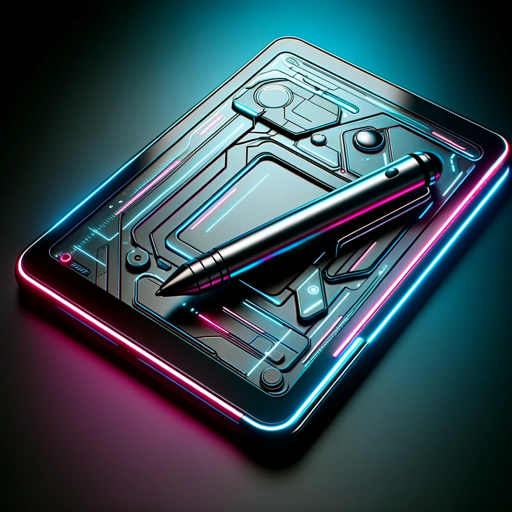Industrial Design-expert guidance on industrial design.
AI-powered industrial design insights.
Related Tools
Load More
Product Design Pro
Expert in product design, offers tailored advice and detailed illustrations.提案したデザインのコンセプトをリアルなイラストで視覚化できます。日本語対応。(24/01/2024 UPDATE)

UX/UI Product Designer
Enhance the usability and appearance of digital products, providing analysis, recommendations, and checklists to optimize the UX/UI design 🚀

Concept Design
3D model concept image creator using DALL-E 3. Copyright (C) 2024, Sourceduty - All Rights Reserved.

Industrial Design Sketch Assistant
Creates industrial design sketches and annotations

UX/Product Design
UX/Product design expert analyzing and auditing UI designs.

产品设计小能手
一个精通产品工业设计,结构设计,电气设计,程序设计的全能型助理
20.0 / 5 (200 votes)
Introduction to Industrial Design
Industrial design is a professional service that focuses on developing and optimizing the form, functionality, and aesthetics of products that are mass-produced. It blends art and engineering to create products that are not only visually appealing but also user-friendly and efficient in their performance. The primary aim is to improve the user experience through innovative and thoughtful design, while also considering factors such as production costs, sustainability, and marketability. An example scenario is the design of a smartphone, where industrial designers work on the device's ergonomic shape, the placement of buttons, and the overall look and feel, ensuring it is both attractive and comfortable to use.

Main Functions of Industrial Design
Aesthetic Enhancement
Example
Designing sleek and modern kitchen appliances
Scenario
A company wants to launch a new line of blenders that stand out in the market. Industrial designers are tasked with creating a visually appealing design that complements modern kitchens while maintaining the product’s functionality. The result is a sleek, polished appearance with intuitive controls that attract consumers and enhance their user experience.
Ergonomic Improvement
Example
Developing ergonomic office chairs
Scenario
An office furniture manufacturer aims to design chairs that provide better support and comfort for users during long work hours. Industrial designers study human body mechanics and workplace needs to create chairs that reduce strain and improve posture, leading to increased productivity and well-being for office workers.
Functional Optimization
Example
Creating user-friendly medical devices
Scenario
A healthcare company needs a new insulin pump that is easy for patients to use. Industrial designers collaborate with engineers and medical professionals to design a device that is simple to operate, with clear instructions and a user interface that minimizes the risk of user error. This enhances the overall safety and effectiveness of the medical device.
Ideal Users of Industrial Design Services
Manufacturers
Manufacturers benefit from industrial design services to create innovative and competitive products. By employing industrial designers, they can enhance product appeal, optimize functionality, and streamline production processes, ultimately leading to increased sales and customer satisfaction.
Startups
Startups often need to differentiate their products in a crowded market. Industrial design services help them develop unique, user-centric products that can attract investors and customers. By focusing on both aesthetics and usability, startups can establish a strong market presence and build brand loyalty.

How to Use Industrial Design
Step 1
Visit aichatonline.org for a free trial without login, also no need for ChatGPT Plus.
Step 2
Familiarize yourself with the basics of industrial design by exploring the provided tutorials and documentation on the platform.
Step 3
Identify your specific project requirements, including target audience, functionality, and design constraints.
Step 4
Utilize the available tools and resources on the platform to create and refine your design concepts, including sketching, modeling, and prototyping.
Step 5
Review and iterate your design based on feedback and testing, ensuring it meets all necessary standards and user needs.
Try other advanced and practical GPTs
护理科研Focus科研顾问
AI-Powered Nursing Research Simplified

언론홍보 보도자료 작성 봇
Automate your press release writing with AI.

Software Engineer Behavioral Interview
AI-powered Insights for Behavioral Interviews

Tech Recruiter
AI-driven insights for tech recruitment.

de imagen a texto
AI-Powered Text Extraction Tool

Guion videos cortos
AI-powered TikTok Script Creator

Asesor Legal de Argentina
AI-Powered Legal Assistance for Argentina

Anime Gal
AI-powered anime character creation

Brief Buddy
Instant, precise answers with AI.

Emergenzia NextGen Super-Turbo-AI
AI-Powered Versatility for Every Task

Podcast Coach Mick by NextGen Podcaster
Elevate your podcast with AI-powered guidance.

Top Down Tokens - Aligned Feet
AI-powered character tokens for seamless tabletop gaming.

- Prototyping
- Product Design
- User Experience
- Concept Development
- Manufacturing
Industrial Design Q&A
What is industrial design?
Industrial design is the process of designing products that are to be manufactured through techniques of mass production. It involves creating and developing concepts and specifications that optimize the function, value, and appearance of products and systems for the mutual benefit of both user and manufacturer.
How does industrial design differ from other design fields?
Industrial design focuses specifically on the physical appearance, functionality, and manufacturability of a product, differentiating it from fields like graphic design, which focuses on visual communication, or UX design, which focuses on user interaction with digital interfaces.
What are common tools used in industrial design?
Common tools include sketching and drawing tools, 3D modeling software like SolidWorks or Rhino, prototyping tools, and various materials for creating physical models. Advanced tools might also include CAD software and 3D printers.
What skills are essential for an industrial designer?
Key skills include creativity and innovation, technical knowledge of materials and manufacturing processes, proficiency in design software, strong understanding of ergonomics and user experience, and the ability to communicate ideas effectively through sketches and presentations.
How can industrial design benefit a business?
Industrial design can significantly enhance a product's appeal and usability, leading to increased customer satisfaction and loyalty. It can also streamline manufacturing processes, reduce costs, and create a strong brand identity, ultimately boosting a company's market competitiveness and profitability.